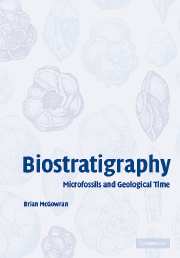Book contents
- Frontmatter
- Contents
- Preface
- Acknowledgments
- 1 Biogeohistory and the development of classical biostratigraphy
- 2 The biostratigraphy of fossil microplankton
- 3 Biostratigraphy: its integration into modern geochronology
- 4 Biostratigraphy and biohistorical theory I: evolution and correlation
- 5 Systemic stratigraphy: beyond classical biostratigraphy
- 6 Biostratigraphy and biohistorical theory II: carving Nature at the joints
- 7 Biostratigraphy and chronostratigraphic classification
- 8 On biostratigraphy and biogeohistory
- References
- Index
Preface
Published online by Cambridge University Press: 02 December 2009
- Frontmatter
- Contents
- Preface
- Acknowledgments
- 1 Biogeohistory and the development of classical biostratigraphy
- 2 The biostratigraphy of fossil microplankton
- 3 Biostratigraphy: its integration into modern geochronology
- 4 Biostratigraphy and biohistorical theory I: evolution and correlation
- 5 Systemic stratigraphy: beyond classical biostratigraphy
- 6 Biostratigraphy and biohistorical theory II: carving Nature at the joints
- 7 Biostratigraphy and chronostratigraphic classification
- 8 On biostratigraphy and biogeohistory
- References
- Index
Summary
Some geologists and palaeontologists recount their awakenings as occurring while collecting minerals and rocks, or when suddenly seeing – really seeing – fossils in rocks for the first time. Others chose geology to fill in the fourth subject in first-year science, as not much more than a happy accident. Many of the teachers at my high school were of the Depression generation for whom teaching was the main career option before the war, and some were indeed excellent in the mathematics-science area. But becoming a successful junior cricketer was more important to me than becoming a scientist. In those days science for the A-stream comprised physics, chemistry and maths, all of which held some interest for me, but that was all. Botany or physiology were for girls, and evolutionary biology and geological time remained as much a shrouded mystery for my generation as it was for our otherwise well-educated antecedents. I came upon W. W. Norton's Physical Geology (1915) by chance at the age of 16 – it had belonged to an aunt who did Geology I with Douglas Mawson – and I became entranced with theories of the landscape and its history which, together with other natural history and human history, were quite absent from my formal education. When I should have been studying for the public exams, I was digging around in the geology section of the Adelaide public library.
- Type
- Chapter
- Information
- BiostratigraphyMicrofossils and Geological Time, pp. xi - xviiiPublisher: Cambridge University PressPrint publication year: 2005

